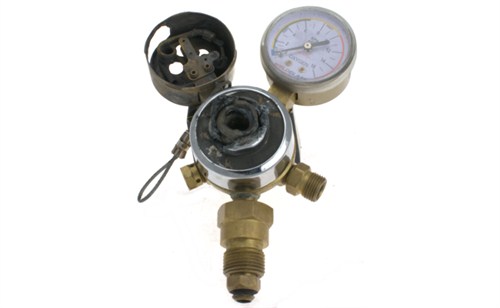Wednesday, December 19, 2012
NEW BLOG - Oxygen Regulator - "The Bomb Test" (AS4267)
When a regulator is labelled compliant with AS4267, it would be
reasonable to think that the regulator fully meets the requirements
and testing of that standard. Unfortunately, that is not
always the case. With so many different brands of AS4267 compliant
regulators available, how can you be sure that the regulator you
are buying has been tested and is safe?

The regulator pictured above is claimed to comply with the
requirements of AS4267 and is labelled as such. Nonetheless,
it has suffered a catastrophic failure due to an explosion
initiated at the inlet stem and a resultant fire. As a
consequence of the explosion, a large part of the bonnet assembly
has been blown away, leaving a gaping hole. The high pressure
gauge has been left burnt out from the ensuing fire.
Testing
There are two types of test detailed in AS4267 for oxygen
regulators; Normative and Informative. Oxygen regulators must
pass all of the normative tests to meet the standard. These
tests include: Oxygen Shock-Type Test, Hydrostatic-Type Test on
High-Pressure Side of Regulator, Gas Pressure Retention-Type Test
on Low-Pressure Side of Regulator, Gas Tightness Test and
Performance Tests.
The Informative test detailed in AS4267 is voluntary; it is
called the Promoted Ignition Test and often referred to as
"The Bomb Test". In this test, the regulator is subjected to
an explosion within the regulator using steel wool, flint and high
pressure oxygen. To pass the test, the high pressure and low
pressure sides of the regulator must maintain their integrity in
containing the explosion and no parts may be ejected from the
regulator.
At Tesuco, we believe that it is imperative to ensure the
highest level of safety to the operators of our equipment. As
a result, all of our oxygen regulators have passed the Promoted
Ignition Test, which means that even in the event of a
catastrophic failure causing internal regulator explosion, the
result pictured above will never occur.
Verification
Upon request, Tesuco are able to supply documentation to verify
that our regulators have met all of the requirements of
AS4267. The documents include test results and flow charts,
as required by the standard. This gives the assurance that
all of the necessary testing has been done, making Tesuco
regulators as safe as possible for our customers.
To ensure maximum safety, you should insist on documented
evidence from your supplier that the regulators meet the design and
testing requirements of AS4267.
Wayne Molloy
Comments
Add Comment